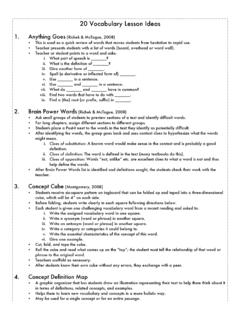Transcription of STRENGTHENING CASE MANAGEMENT: INTRODUCING …
1 STRENGTHENING case management : INTRODUCING narrative CONCEPTSJOAN HODGES, MANCB WEBINAR DEC 19, 2012 Workshop Summary This webinar presents narrative therapy as a potential therapeutic approach that can be appropriately adjusted for use in a case management (CM) setting. Using narrative concepts, case managers can use narrative interviewing as a way to help clients deconstruct problems in order to create an alternative, preferred Objectives To gain a basic understanding of narrative therapy To discuss the potential for narrative theory in case management To identify and utilize basic narrative concepts To understand the limitations of the narrative model in CMWhat is narrative Therapy? Form of psychotherapy pioneered in Australia and New Zealand in the 1980 s Focuses on the stories of people s lives Problems are manufactured in social, cultural, and political contexts Based in social constructionism Post-modern approach Lives seen as multi-storied vs.
2 Single storiedWhite, M., & Epston, D. narrative means to therapeutic ends. New York: WW Norton and Company, 1990. Focus on the Self-Story Self-story provides insight into social contexts Life events are selected, ranked, and linked together Self-story told to ourselves and others narrative constantly changing Reasons that because our lives are shaped by our stories, then individuals also have the power to change their lives by changing their stories Dominant Cultural Narratives Cultures send powerful messages about social groups Dominant cultural narratives are communicated via one s self-story Negative cultural narratives often create negative personal narrativesFreedman, J. & Combs, G.
3 (1996). narrative therapy: The social construction of preferred realities. New Yo r k : W. W. N o r t o n . narrative Concepts in CM Uses therapeutic questioning to deconstruct client narratives Listener focuses on the effects of problem vs. the cause of problem Push to develop a richer, more complex self-story Emphasis on the construction of a preferred client identity Collaboration is client-leadWhite, M., & Epston, D. narrative means to therapeutic ends. New York: WW Norton and Company, 1990. narrative Opportunities in CM Resettlement & acculturation offer clients new social contexts Concepts are universal, culturally sensitive, flexible, and responsive Compliments a strength-based approach Does not require psychotherapy trainingNarrative Opportunities in CM Concepts have been useful working with: LGBTQ clients Rape survivors Cultural outcasts Clients with strong feelings of failure Clients in conflict with cultural norms The person is not the problem, the problem is the problem.
4 White M, Epston D. narrative means to therapeutic ends. New York: WW Norton and Company, 1990. Client Example: AngelaImage courtsey of Problem-Saturated Story Parry, A.,& Doan, Story Revisions: narrative therapy in the postmodern world. New York: Guilford Press, 1994. Clients are often stuck in problem-saturated stories. Stories become disabling when clients feel they have lost control over their lives and unable to change their future. Problem-Saturated Story Parry, A.,& Doan, Story Revisions: narrative therapy in the postmodern world. New York: Guilford Press, 1994. Clients are often stuck in problem-saturated stories. Stories become disabling when clients feel they have lost control over their lives and unable to change their : You said you don t have any strengths.
5 Why is that?Angela: I just don t. It s like I m not good at anything. My sisters are beautiful and they can do many things but I m not good at anything. My mother tells me I should be married with babies by now. I can t even do that right. Renaming the Problem Encourage the client to come up with their own description of the problem. Clients often find it easier to talk about the problem by choosing the exact language that represents their the Problem Encourage the client to come up with their own description of the problem. Clients often find it easier to talk about the problem by choosing the exact language that represents their : What would you call this problem if you saw it in another person?
6 Angela: I d call it feeling like trash. People just told me so long that I m no good so now I can t think about things that I like about me. Externalizing the Problem Distance the client from problem by locating it outside the individual and within the culture. CM and client can ally against M, Epston D. narrative means to therapeutic ends. New York: WW Norton and Company, 1990. Externalizing the Problem Distance the client from problem by locating it outside the individual and within the culture. CM and client can ally against M, Epston D. narrative means to therapeutic ends. New York: WW Norton and Company, 1990. CM: Where did the idea of feeling like trash come from?Angela: I ve felt that way for a long time, ever since I was back home [in Africa.]
7 ] My mother has always been mean to me. And because of other people the Effects Explore the influence the problem has on the client s life and how the client has influence over the the Effects Explore the influence the problem has on the client s life and how the client has influence over the : Can you think of a time when feeling like trash didn t control you? Tell me about : I don t know, but, uh, sometimes when people give me compliments I feel good. Like when I was at the bus stop, a woman said she liked my for Exceptions Help client replace the problem-saturated story by constructing a preferred story Emphasize hopeful moments, thoughts, and events that do not fit with the problem storySearching for Exceptions Help client replace the problem-saturated story by constructing a preferred story Emphasize hopeful moments, thoughts, and events that do not fit with the problem storyCM: Tell me more about your conversation with the woman at the bus stop?
8 What exactly happened?Angela: She just said she like my scarf. That s all. [Pause] Um, I really like fashion, you know. Before my sisters go out, they always ask me to come over and style them. I really like doing that. It s a Preferred Identity Encourage client to recognize preferred qualities in a Preferred Identity Encourage client to recognize preferred qualities in : So what does it say about you that your sisters ask for your help?Angela: Um, it says that they like me and I m not trash to them. And I think it also means that I like to help people. CM: So now that we ve talked, if someone asked you about your strengths, what would you say? Angela: I d say that I like to help people and I love fashion and styling.
9 And that I like help my sisters and I like to make people feel OF narrative QUESTIONSTERMPURPOSEEXAMPLED econstructive Show how stories are constructed; situate narratives in larger systemWhere did this idea of not beinggood at anything come from? Can you remember when it first began?RenamingSupport patient efficacy by sharing authorship and expertise with clientWhat would you call this problem of not being good at anything?PerspectiveExplore other people s views of clientDoes everyone think you are trash, or can you think of someone who doesn t?Opening SpaceAllowing hopeful thoughts, actions to surface and be explored; highlight patient efficacy regarding problemAre there ever times when feeling like trash doesn t control you?
10 Tell me about (Miracle)Stimulate client s imagination to envision different, more hopeful futuresSuppose a miracle happened and you no longer felt like trash. How would your life be different?TYPES OF narrative QUESTIONS (cont.)TERMPURPOSEEXAMPLEP referenceCheck to make sure that exceptional moments are actually preferred to the problem storyHow did you feel when you think of yourself as trash? Isthis something that you want?Story DevelopmentExplore and linger on elements of the preferred storyTell me more about your conversation with the woman at the bus stop. What exactly happened?RedescriptionHelp client recognize preferred qualities in themselves and probe implications for identityWhat does it say about you that your sisters ask you to help style them?











